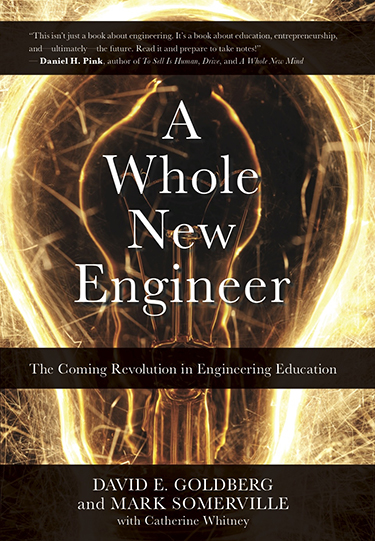|
Subscribe / Renew |
|
|
Contact Us |
|
| ► Subscribe to our Free Weekly Newsletter | |
| home | Welcome, sign in or click here to subscribe. | login |
Architecture & Engineering
| |
 |
October 30, 2014
Why tomorrow’s engineer needs a different education
Special to the Journal

Goldberg
|

Somerville
|
In 2008, the oddest couple since Oscar and Felix met and collaborated on how to change the shape of engineering education forever.
In that year faculty at a small, private upstart college, the Franklin W. Olin College of Engineering, and faculty at a big, established public research university, the University of Illinois at Urbana-Champaign, got together to come up with a different way of looking at education reform — a way that may have implications beyond engineering for architecture, business school, and all forms of professional education.
This journey is chronicled in a new book entitled “A Whole New Engineer: The Coming Revolution in Engineering Education.”
The book makes the following key points:
1. Stop taking the crisis in engineering education for granted.
Start working diligently until engineering is attractive to our best and brightest. We live on a planet with 7 billion people. Without technology, 6.9 billion of us or so would have to die or be culled. Yet, in advanced cultures the best students want to be anything but engineers. For the planet’s survival and quality of life, creating inspirational engineering education is a globally urgent imperative.
2. Stop basing the education system on an operating system of fear.
Start building a new operating system that works through joy, connection and openness. The main reason students go to other fields is they view engineering education as a soulless sorting process, a survival of the fittest, where they must pass a harsh fraternity hazing before they are allowed to practice the chocolate of engineering design. Giving students a taste of the chocolate early makes the process a joyful one, thereby attracting and retaining students.

3. Stop boring our students into dull obedience.
Start trusting them until they have the courage to be creative and unleashed. Our education system is based on memorizing and regurgitating facts that are now widely available to anyone with a laptop. This worked in the 1950s when we wanted technical drones to do the bidding of large hierarchies.
Now we want innovative and creative engineers (the next Steve Jobs), but we educate the creativity out of them by sticking to the mind-numbing old ways. Instead, we need to give them real-world challenges and trust them until they find the courage to fail and then succeed. In a word, we need to unleash them.
4. Stop educating engineers as technical brains on a stick.
Start educating engineers with six minds: analytical mind, design mind, linguistic mind, people mind, body mind and mindful mind. Math and science are important to engineers, but educating math robots instead of more reflective engineers misunderstands how engineering is really practiced and discourages and drives out the capable.
5. Stop throwing Ph.D.s into classrooms as experts.
Start training a new generation of skilled educators with both technical knowledge and an ability to coach young people. Modern companies spend $500 an hour to provide executive coaches to the C-Suite with sharp skills (stop calling them soft skills).
About 80 percent to 90 percent of our educational difficulty comes from Ph.D.s trained as narrow specialists with a lack of sharp skills in noticing, listening and questioning, and speech acts. Replacing fear with joy, boredom with unleashing, and narrow technical skills with the whole new engineer requires educators with the sharp skills of a coach.
6. Stop assuming that educational transformation can be performed by a system designed in the 11th century, a system designed to maintain the status quo.
Start to use new methods of change management to bring about the needed change. Deans, department heads and faculty assume that changes can be made through existing channels in the system. Olin was a blank slate. The initiative at Illinois was an incubator of educational change.
Change and leadership expert John Kotter says we need a dual operating system for effective change. Let’s use learning from the corporate world and educational initiatives as best practices in making academic change.
One of the surprising conclusions of this work has been the way in which the usual rational approaches to education reform — content, curriculum and pedagogy — have been replaced by a concern for decidedly emotional and cultural variables.
Coming to this conclusion was especially difficult for a pair of traditionally trained engineering educators, but over and over again, we saw students unleashed to a life full of engaged and pervasive learning where they were trusted, took courage from that trust, and took initiative that resulted in authentic learning. And once students were unleashed to authentic learning like this, they are able to apply it in other domains and throughout their lives.
In short, once we got to the emotional floor of the educational enterprise, we knew there was no going back, and once others can bring themselves to speak of education in this way, they are better able to help bring about the needed changes.
David E. Goldberg is president of the nonprofit Big Beacon, and a computer scientist, civil engineer and professor emeritus at the University of Illinois at Urbana-Champaign. Mark Somerville is a professor of electrical engineering and physics at Olin College, where he also serves as associate dean for faculty affairs and development. They authored, with Catherine Whitney, “A Whole New Engineer: The Coming Revolution in Engineering Education.”
Other Stories:
- 5 tools needed to run successful meetings
- Survey: Magnusson Klemencic Associates
- Survey: PCS Structural Solutions
- Survey: Graphite Design Group
- Survey: Notkin Mechanical Engineers
- Survey: Walker Macy
- Survey: Callison
- Survey: CollinsWoerman
- Energy-efficient design goes to school
- Is Seattle’s housing market falling into the ‘San Francisco Death Spiral’?
- Lean design shines in tricky healthcare projects
- Commissioning is key to a smooth running central utility plant
- Electronic data loss can become a shocking surprise
- D/B competitions: a high-stakes poker game you can’t win
- Survey: Driftmier Architects


